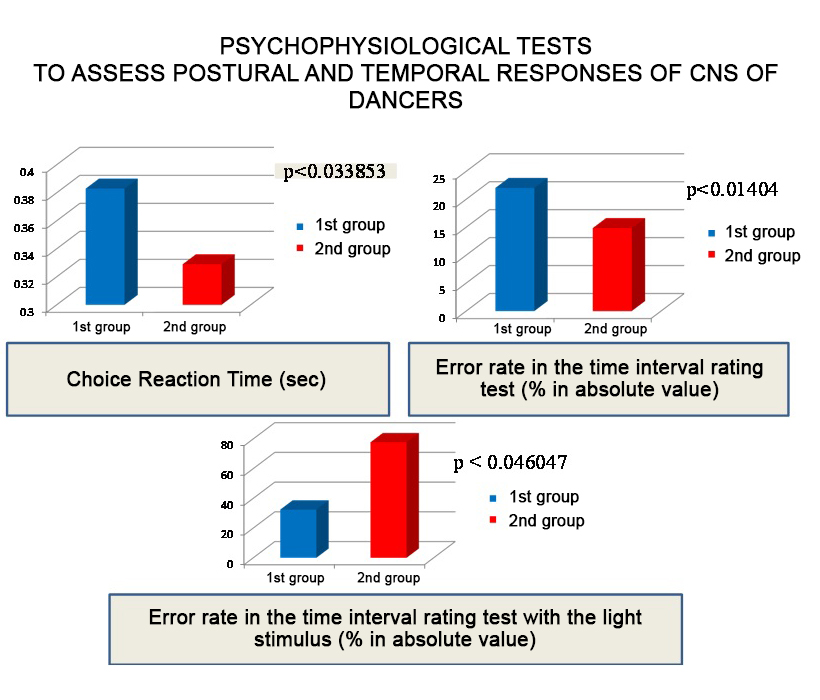Elite dancers’ exposure to breathing rhythm disorders under competitive stress
Фотографии:
ˑ:
Dr.Med., Professor N.N. Zakharyeva1
PhD, Professor E.N. Yashkina1
Master's student E.I. Maliyeva1
1Russian State University of Physical Education, Sports, Youth and Tourism (GTSOLIFK), Moscow
Keywords: elite dancers, breathing rhythm disorder under competitive stress, reflective responses of central nervous system, balancing ability in Romberg test, physical working capacity, heart rate.
Introduction. Dancesport is a modern and rapidly developing sport [6]. The main success criterion in dancesport is the result in the final. The literature on dancesport [1, 2] reveals the factors that negatively affect the quality of dance performance by a dance couple and, consequently, the expected result in the final. In terms of "transparency" of judging, the dancesport specialists singled out the following key factors: dance movement technique violation "Technical Qualities" (TQ), lack of rhythmicity and violation of musicality "Movement to Music" (MM); partner-partner desynchronization "Partnering Skill" (PS); motor skill derivation "Choreography and Presentation" (CP) (WDSF judging system 2.0 [2]. All the above violations can be due to the breathing rhythm disorders under competitive stress [5].
Objective of the study was to rate breathing rhythm disorders and variations in elite dancers under competitive stresses.
Methods and structure of the study. Subject to the study were 46 elite dancers (Class А-M) aged 18-22, all having 10-16 years of experience in dancesport. The number of training sessions per week equaled from 12 to 42 hours. According to their sports qualification, the dancers were distributed as follows: International Class Masters of Sport (ICMS) - 2.2% (1 person); Masters of Sport (MS) - 6.6% (3 people); Candidate Masters of Sport (CMS) - 28.2% (13 people), І Senior - 63% (29 people). Apparently healthy athletes, elite dancers assigned to I-II health groups who did not have any acute or chronic diseases at the time of examination were surveyed. The studies were conducted within the annual training cycle. The external respiration system functionality was tested by SPIRO C-100 Spirometer Unit, their physical working capacity was assessed based on the results of the bicycle ergometer test PWC170, coordination abilities – by the balancing ability in the Romberg test (vertical position, 3rd test option), the "Targeting" test was based on the stabilometric indicators (TRUST-M Stabilograph). The psychophysiological tests included: computerized tapping test; intellectual capacity rating using the URA test - 3 levels of mental load; simple visual motor reaction (SVMR) indicators, results of the psychophysiological testing of the postural and temporal responses of the central nervous system (CNS) of the athletes according to the program ISTP v.2.1. Trait anxiety was rated using the Taylor’s Manifest Anxiety Scale.
Results and discussion. We detected the differences in blood pressure and respiratory system functionality rates, psychophysiological and functional indicators, physical qualities of elite dancers in terms of different levels of severity of breathing rhythm disorders in the final. According to the questionnaire survey, 100% of athletes have breathing rhythm disorders under competitive stress. The dancers were divided into 2 groups by the level of severity of breathing rhythm disorders: 1st - 30 people (65.2%) with mild breathing rhythm disorders and 2nd - 16 people (34.8%) - with moderate ones. Elite dancers with the breathing rhythm disorders who got 3 points after their performance were not detected. We developed a 3-point scale for subjective evaluation of the level of severity of breathing rhythm disorders in the dancers performing consecutive dance programs. Individual stress susceptibility in the Taylor’s test was determined by the athlete’s level of anxiety. This test revealed the intergroup differences. In the 1st group had more low-anxiety athletes with a lower level of moderate and especially high anxiety compared to the 2nd group. Twice as many high-anxiety dancers were found in the 2nd group. The 1st group subjects were found to have no correlations between the test indices and other functional systems rates. In the 2nd group correlation dependencies on the physical qualities were observed: carpal dynamometry (r=-0.50) and flexibility (r=0.65), as well as on the vegetative indices: diastolic blood pressure - DBP (r=0.44), average inverse correlation dependencies on the IRV values (r=-0.55), VC (r=-0.45).
Among the parameters characterizing the postural and temporal responses of the CNS, significant intergroup differences were obtained in the following tests: "Choice reaction time" (s): in the 1st group the mean value (m) equaled 0.383±0.05904 versus m=0.32±0.128 in the 2nd one; the response error test in the time interval rating test with a light stimulus (% in absolute values): m=32.440±6.904 versus m=77.730±64.365 in the 1st and 2nd group respectively. However, in the response error test in the time interval rating test (% in absolute values), the 1st group dancers demonstrated better results and amounted m=15.94±6.904 versus m=16.23±7.512 in the 2nd group, the intergroup differences were statistically significant (p<0.05) (Figure 1).

Fig. 1. Psychophysiological tests to assess the postural and temporal responses of the CNS of dancers
Intellectual workability was tested using the URA test (V.V. Sonkin, V.D. Sonkin, V.P. Zaitseva, 2002). The study consisted of 3 stages: stage 1 - a 3-letter test, stage 2 - a 10-letter test and stage 3 - a 10-letter one at a constant speed. We detected the statistically significant differences in the development of fatigue in all 3 tests. The most significant differences in the 3-letter test were observed in the following cases: fatigue in the 2nd group dancers developed at the 5th attempt (p<0.015948), starting from the 6th attempt and especially at the 7th and 8th attempts the 2nd group dancers made significantly more errors (the degree of significance is high (p<0.013596 and p<0.000897).
We studied the balancing ability in the advanced Romberg test (pose): one-leg standing test, another leg being 90о bent with the foot on the knee of the supporting leg, arms extended forward, eyes closed (pose No. 3). There were statistically significant intergroup differences in the lower balancing time in the Romberg test: 1st group, m=56.66±27.58s, 2nd group - m=32.56±15.87s (p≤0.05).
There were significant differences in the physical working capacity rates PWC170 (kgm/min): m=23.22±4.67s in the 1st group versus m=20.42±4.04s in the 2nd group (p≤0.05).
Conclusion. The problem of strained breathing in the final is relevant for modern dancesport. The differences in the functional state of dancers with different levels of strained breathing are expressed in significant postural and temporal response errors of the CNS in the test "Error rate in the time interval rating test", decreased intellectual capacity at 3 stages of the URA test, lower balancing time in the Romberg test and decreased physical working capacity of dancers with the most severe breathing rhythm disorders. The revealed changes may negatively affect the quality of dance performance, reduce the sports result of elite dancers in the final and demonstrate the need for the dancers’ training systems to be individualized with a special attention to the individuals most vulnerable to breathing disorders.
References
- Borovskiy A.V. Sistema tsennostey i lichnostnye orientiry v professii pedagoga sportivnogo balnogo tantsa [System of values and personal guidelines in ballroom dance teacher profession]. Mater. V Mezhvuz. nauch.-prakt. konf. 'Iskusstvo tantsa v dialoge kultur i traditsiy' [Proc. V Inter-university res.-practical. conf. 'Dance art in dialogue of cultures and traditions']. St. Petersburg: SPbSUP, 2015, 112 p. (link pp. 54-61). [Internet resource]. Available at: http://www.gup.ru/events/news/smi/dance_2015.pdf (date of access: 19.03.2016)
- Voronin R.E. Evolyutsiya sistemy sudeystva v tantsevalnom sporte (na analize sistemy sudeystva WDSF) [Evolution of judging system in dance sport (case study of WDSF judging system]. Mater. V Mezhvuz. nauch.-prakt. konf. 'Iskusstvo tantsa v dialoge kultur i traditsiy' [Proc. V Inter-university res.-practical. conf. 'Dance art in dialogue of cultures and traditions']. [Internet resource] Available at: http://www.gup.ru/events/news/smi/dance_2015.pdf (date of access: 19.03.201).
- Zakhar'eva N.N., Belitskaya L.A., Kotenko N.V. et al. Osobennosti vegetativnykh pokazateley tantsorov pri ispolnenii balnoy i latinoamerikanskoy programm [The features of vegetative indices of dancers when performing standard and Latin programs]. Teoriya i praktika fiz. kultury, 2012, no. 6, pp. 23-27
- Zakhar'eva N.N., Vinokurova E.R. Znachenie biotipologicheskogo podkhoda v trenirovochnom protsesse tantsorov vysokoy kvalifikatsii [The Value of Biotypological Approach in Training of Elite Dancers]. Fizicheskaya kultura: vospitanie, obrazovanie, trenirovka, 2014, no. 1, pp 26-30.
- Zakhar'eva N.N., Singina N.F., Sirotenko S.V. et al. Problema sryva ritma dykhaniya u tantsorov vysokoy kvalifikatsii v finale sorevnovaniy [Failure of respiratory rhythm in elite dancers in the final]. Teoriya i praktika fiz. kultury, 2016, no. 1, pp. 31-34.
- Sirotkina I.S. Svobodnoe dvizhenie i plasticheskiy tanets v Rossii [Free Movement and Plastic Dance in Russia]. 2nd ed. Moscow: Novoe literaturnoe obozrenie, 2012, 328 p.: il.
Corresponding author: zakharyeva.natalia@mail.ru
Abstract
Objective of the study was to rate breathing rhythm disorders and variations in elite dancers under competitive stresses. Subject to the study were 47 dancers diagnosed with different breathing rhythm disorders due to emotional surges in competitive routines. The dancers with the most severe breathing rhythm disorders were tested with the postural and temporal response errors of the CNS in the time interval rating test; lower fatigue tolerance as verified by the URA test; lower balancing ability in the Romberg test; and lower physical working capacity rates. The test data may shed light on the sudden competitive performance sagging effects and demonstrate the need for the dancers’ training systems to be individualized with a special attention to the individuals most vulnerable to breathing disorders.



 Журнал "THEORY AND PRACTICE
Журнал "THEORY AND PRACTICE